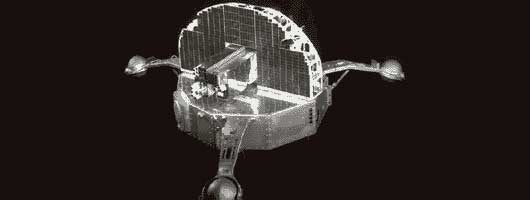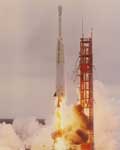OSO-3
Orbiting Solar Observatory-3

OSO-3 was designed to measure the ultraviolet through gamma ray radiation from the sun and the celestial sphere, and to characterize the spatial and energy distributions of the radiation. The initial approved mission lifetime was six months.
 OSO-3 was launched by a Thor-Delta rocket on March 8, 1967 into a nearly circular orbit at 550 km altitude and 33 degrees inclination. It therefore had a 95.6 minute orbital period. One of the two on-board tape recorders stored all telemetry for 90 minutes, and telemetered the data to ground stations in five minutes once per orbit. The tracking stations were at Ft. Meyers, Florida and on the west coast of South America. Data was collected in this way until the second tape recorder failed on June 28, 1968.
OSO-3 was launched by a Thor-Delta rocket on March 8, 1967 into a nearly circular orbit at 550 km altitude and 33 degrees inclination. It therefore had a 95.6 minute orbital period. One of the two on-board tape recorders stored all telemetry for 90 minutes, and telemetered the data to ground stations in five minutes once per orbit. The tracking stations were at Ft. Meyers, Florida and on the west coast of South America. Data was collected in this way until the second tape recorder failed on June 28, 1968.
OSO-3 performance far exceeded the lifetime design of six months. Spacecraft temperatures remained stable in the 15-17C range, and the spacecraft line voltage and detector photomultiplier tube high voltages remained stable within the 0.5% readout accuracy of the telemetry. The spacecraft magnetometer and sun sensor systems usually gave sufficiently good data to calculate aspect with 1-3 degree confidence.
--- Ph. D. Theses ---
D.L. McKenzie, 1971, UCSD, "A Study of Correlation of Hard Solar X-ray and Radio Emission"
D.A. Schwartz, 1969, UCSD
R.M. Pelling, 1971, UCSD
OSO-3 Information
Mission Objectives
Spacecraft
X-Ray Telescope
Scientific Results
Publications